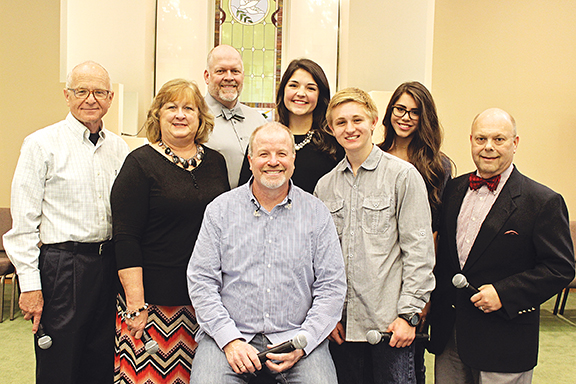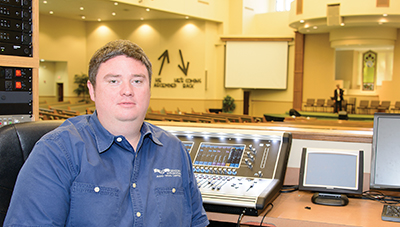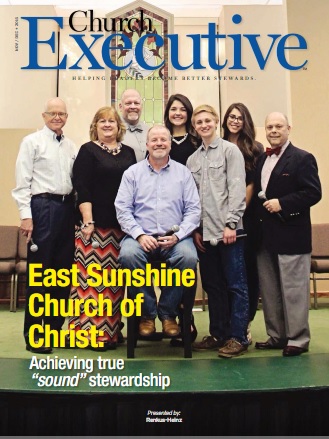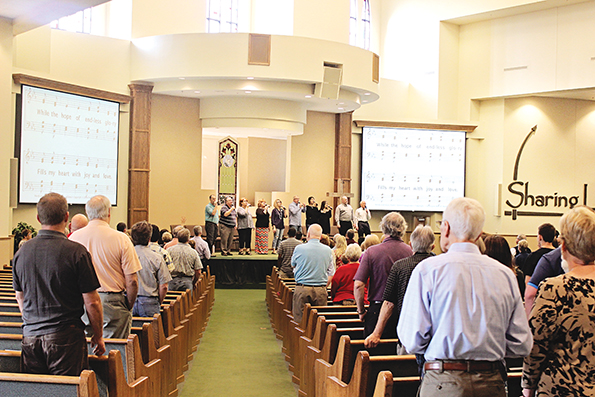
Pictured, from left to right: Myron Mizell, Barbara Smith, Jeff Broussard, Randy Wray, Sophia Broussard, Josh Parnell, Toria Smith, Rick Schnake
The perfect audio balance.
How a uniquely shaped, acapella-loving worship space (finally!) struck just the right chord.
![]() At East Sunshine Church of Christ in Springfield, MO, four-part acapella harmonies are a worship staple. It’s been that way for more than 180 years since the church was established. This approach to worship music is unique, beautiful — and challenging.
At East Sunshine Church of Christ in Springfield, MO, four-part acapella harmonies are a worship staple. It’s been that way for more than 180 years since the church was established. This approach to worship music is unique, beautiful — and challenging.
Built in 2002, the sanctuary at East Sunshine is all those things, too. That meant, until recently, it was a source of disharmony with the church’s signature musical style.
With a 60-foot-high peaked ceiling; a wide, 1,500-seat, fan-shaped worship space; and a very large — read: acoustically reverberant — rear wall, East Sunshine’s hard-to-achieve harmonies often fell on deaf ears. That’s a shame (not to mention, a big problem!) when singing along is such a big part of the worship experience.
“We rely on people in the congregation being able to hear their part,” explains Worship Pastor Randy Wray. “When it’s muddled and there’s no distinction, it’s very hard to sing and appreciate the four-part harmony.”
This wasn’t news for church leaders. On Sundays, people had long had difficulty hearing the music, as well as the spoken word.
During special events featuring East Sunshine’s and several other local churches’ music ministries, it was similarly difficult to make out the acapella tunes and instrumentals.
“Our system wasn’t even close to capable,” recalls Darren Smith, a 36-year member of East Sunshine and consultant / installer for Springfield, MO-based Sensory Integration.
For five years, Smith and his team sought a solution.

In most large spaces, he says, a fix requires much larger-format speakers than what East Sunshine had in place. Though there were 10 speakers in a distributed audio system, none was large enough to truly deliver. “I think the largest driver in any of them was an 8-inch speaker,” Smith says. “They actually blew one of the speakers trying to deliver speech intelligibility and accommodate instrumentals.”
Even so, larger-format speakers weren’t an option, aesthetically. “In that building, there was no place to hang anything,” he points out. “And they didn’t want line arrays; they didn’t want big J-hooks coming down.”
Still, Smith and his team conducted a variety of demos with some well-known manufacturers’ products. Though they tried a variety of line arrays, they could never achieve the coverage they were looking for.
Suffice it to say, then, church leaders weren’t ignoring the problem — but they had, effectively exhausted their audio system options. For a long time, they learned to live with decidedly less-than-stellar intelligibility … until things reached a breaking point.
As Wray recalls, it happened during a benefit for a local outreach group. A comedian was hired to entertain a crowd of 1,000.
“The intelligibility was so awful!” he says. “He would tell a joke, and his voice would get quiet, and it was, like, ‘Uh…’ I mean, talk about a tough crowd!”
Cautiously optimistic: a (possible) solution emerges
Smith and his team went back to the drawing board, eager to rectify once and for all the intelligibility problems plaguing the worship space.

“If someone sat very close to the preacher, they would get the natural sound, and they could see his lips move. So, those people felt like they heard him well,” Smith recalls. “But the speech intelligibility in the rest of the space was really difficult, muffled — especially if you had any type of hearing loss at all, even if it was minor.
For worshippers in the front several pews (but not close enough to the preacher to hear him naturally), the audio was often “too loud.” As Smith explains, there was too much reflection from the monitors on the stage, though they’re key to the four-part acapella harmony.
“It was loud because [worshipers] would hear more than one reflection,” he says. “In my opinion, the loudness was more distortion. People can listen to loud music if it’s crystal clear; but, if it’s distorted, it’s annoying.”
Overall, Smith estimates half the congregation was listening to reflected sound; the other half was probably listening to direct sound. “Everything was an echo.”
A big part of the problem: The sound source for many parishioners was a speaker installed 60 feet in the air, at the peak of the roof. “That — plus the fact that the side speakers bounced off the walls because there was no control — meant that no matter where you sat, there was either a reflection issue, a coverage issue, or a sound pressure level (SPL) issue,” Smith points out.
It’s no surprise, then, that when a new, smaller line of digitally steerable cluster-type line arrays hit his radar, Smith was eager to give them a try. The product was the IC2 loudspeaker from Renkus-Heinz.
One IC2 can deliver as many as four individually controllable beams of sound. Arraying multiple IC2 loudspeakers delivers a truly steerable line array — all suspended from a single point.
After trying so many different demos (primarily other line arrays) in the space without achieving the coverage needed, it turns out the “magic combination” was a dual IC2 in the middle of the stage — cut into the proscenium overhead — and an IC Live Loudspeaker from Renkus-Heinz on either side of the wide worship space.
Designed with high-output performance in mind, IC Live delivers a full-range musical performance while maintaining the beam control that keeps the sound off the room and only on the audience. Described by the manufacturer as “the intelligent evolution of the small-format line array,” IC Live was ideally suited to delivering intelligible speech in a reverberant space, like East Sunshine.
Smith, for one, was thrilled.
“We were finally able to cover the auditorium!” he recalls. “Before, we could never cover it properly without putting so much sound onto the stage that it caused issues.”
It works, he says, because the center cluster is louder by a minute amount. “So, when you’re listening in that auditorium, your ear is drawn to the center of the stage, even though you’re listening to the speaker that’s to the far left,” Smith explains. “We didn’t take the audience and send them left or right. We wanted to draw them to the speaker and the singers in the middle. Essentially, we ‘tricked’ the congregation to be looking at the stage by using the line array, its steerability, time delays and phase shift across the auditorium.”
It wasn’t the church’s first introduction to Renkus-Heinz’s loudspeakers. Before, they’d tried out a 12-foot version of the same type of loudspeaker technology in the challenging space. “But, we had no place to put that,” Smith says. “So, we tried to do an offset.”
Though the team installed the unit upfront, there was so much feedback on the stage that the singers couldn’t hear themselves.
Amazingly, when IC2 was introduced, Smith and his team discovered it could deliver exactly the same level of control as the tall line array, but in a height of just 18 inches.

Practicing “sound” stewardship
With a workable solution finally in hand, Smith and his team were excited to share it with the church leadership, including more than a dozen elders. The only problem? A healthy dose of hesitance.
“Initially, they said, ‘Well, we’ve signed off on this kind of thing before,” Smith recalls. “’It sounds good when the room’s empty — but let’s see how it sounds on Sunday.’”
He was happy to oblige. For two full Sundays, Smith and his team demoed the new setup at worship services. To demonstrate its versatility, they used it for a Sunday morning service and then turned around and used it in the evenings for community-wide services. “It did both perfectly,” Smith recalls.
As the Worship Pastor, Randy Wray was, of course, involved in the decision. He and Senior Pastor Deron Smith had heard the results for themselves; now, they needed to get buy-in from a group of 12 church elders. They came to the church one night and were shown what the system could do.
Their excitement was immediate.
“[Smith] had a proposal ready,” Wray recalls. “We met that night, said yes, and put it into play.”
A problem solved — and another created
Months later, church leaders are still receiving praise for having solved the “mystery” of great sound in the challenging worship space at East Sunshine. Wray says the feedback has been “all positive.”
And even though he doesn’t understand all the technical aspects behind why this particular combination delivers so well, Wray says the coverage in the room is “really something else.”
“It doesn’t matter where you sit in the auditorium now, there’s no issue with intelligibility — especially the spoken word,” he says. “It’s been a world of difference.”
The only drawback? Now, his acapella harmonies have to be spot-on.
“With the previous system, we could actually get away with weaker singers onstage!” he laughs. “As soon as I heard the new system, my first thought was: We need to get better, because people are going to hear everything.”
— Reporting by RaeAnn Slaybaugh
QUICK FACTS ABOUT EAST SUNSHINE CHURCH OF CHRIST
Year Established: 1834
Location: Springfield, MO
Number of full-time staff: 5
Combined weekend attendance: 450
2016 budget: $700,000



i need the lessonson stewardship.